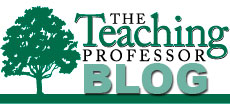It’s hard to say—we have no definitive measures of learner-centeredness or even mutually agreed upon definitions. And yet, when we talk about it, there’s an assumption that we all understand the reference.
 My friend Linda recently gave me a beautifully illustrated children’s book that contains nothing but questions. It reminded me how good questions, like beams of light, cut through the fog and illuminate what was once obscured. And so, to help us further explore and understand what it means to be learner-centered, I’ve generated a set of questions. For the record, these questions were not empirically developed, and they haven’t been validated in any systematic way. However, they do reflect the characteristics regularly associated with learner-centered teaching.
My friend Linda recently gave me a beautifully illustrated children’s book that contains nothing but questions. It reminded me how good questions, like beams of light, cut through the fog and illuminate what was once obscured. And so, to help us further explore and understand what it means to be learner-centered, I’ve generated a set of questions. For the record, these questions were not empirically developed, and they haven’t been validated in any systematic way. However, they do reflect the characteristics regularly associated with learner-centered teaching.
Questions like these can be useful in helping us to confront how we teach. They produce the most insights when asked sincerely and answered honestly. For most of us, there’s a gap between how we aspire to teach and how we actually teach. Given the less-than-objective view we have of ourselves as teachers, it’s easy to conflate aspirations with actualities.
The questions also can be used to prompt discussion between colleagues who wish to help each other explore the extent to which their teaching is learning-focused. They can be used by cross-disciplinary groups whose views, framed by what they teach, show how learner-centeredness looks from different angles. And, they can be used by departments or programs who aspire to be student-centered and need benchmarks to assess their progress. The question set is a work in progress, and I welcome your feedback on how we can make it better. Are we missing important questions? Should some questions be taken off the list? Please share in the comment box.
It’s good to remember that the characteristics identified in the questions are part of something larger. They define the concept operationally and with helpful details, but individual characteristics, even a collection of them, still provide an incomplete picture. It’s a bit like dissecting a flower. The parts are all there to examine, but they’re separate, and a flower is best understood and enjoyed in its integrated wholeness.
Characteristics of learner-centered teaching
- Does the course contain activities that put students in positions to learn from and with each other?
- Are students encouraged to discover things for themselves, or does the teacher usually tell them what they should know and do?
- Are there policies and practices in the course that promote the development of autonomous, self-directed learning skills?
- Is student input solicited on course topics, policies, assessment methods, and class activities?
- Is collaboration emphasized more than competition in the course?
- Is what’s being learned, why it’s being learned, and how it can be learned discussed more often than grades?
- Are students voluntarily participating or do they sit silently until called on to answer questions and make comments? Does their nonverbal behavior indicate they’d rather not speak?
- Do students talk more than the teacher during class discussions? Do students respond to each other or only to the teacher?
- Is it a course where questions play a more prominent role than answers?
- Are students being taught how to answer their own questions?
- Are mistakes handled as learning opportunities for the teacher and the students?
- Are skills like critical thinking and problem-solving taught explicitly?
- Is the teacher modeling how expert learners handle problems, find answers, deal with failure, and celebrate success?
- Are students being given the opportunity to develop self- and peer-assessment skills?
- Do students have the chance to practice the principles of constructive feedback (when they provide input about the course and/or about the work of their peers)?
- Do students regularly comment on evaluations that it was a course where they had to think? Or, was a course where they had to teach themselves (meaning the teacher held them responsible for learning)?
Additional articles on this topic:
- Five Characteristics of Learner-Centered Teaching
- Learner-Centered Pedagogy and the Fear of Losing Control
- Five Ways to Teach Students to Be Learning Centered, Too

